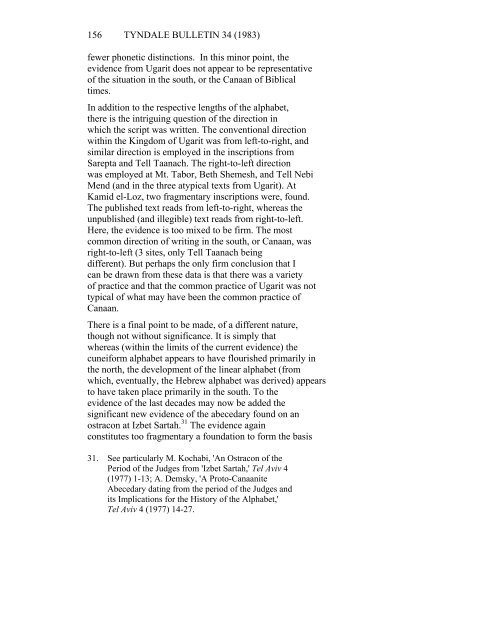UGARIT, CANAAN, AND ISRAEL.pdf - Tyndale House
UGARIT, CANAAN, AND ISRAEL.pdf - Tyndale House
UGARIT, CANAAN, AND ISRAEL.pdf - Tyndale House
Create successful ePaper yourself
Turn your PDF publications into a flip-book with our unique Google optimized e-Paper software.
156 TYNDALE BULLETIN 34 (1983)<br />
fewer phonetic distinctions. In this minor point, the<br />
evidence from Ugarit does not appear to be representative<br />
of the situation in the south, or the Canaan of Biblical<br />
times.<br />
In addition to the respective lengths of the alphabet,<br />
there is the intriguing question of the direction in<br />
which the script was written. The conventional direction<br />
within the Kingdom of Ugarit was from left-to-right, and<br />
similar direction is employed in the inscriptions from<br />
Sarepta and Tell Taanach. The right-to-left direction<br />
was employed at Mt. Tabor, Beth Shemesh, and Tell Nebi<br />
Mend (and in the three atypical texts from Ugarit). At<br />
Kamid el-Loz, two fragmentary inscriptions were, found.<br />
The published text reads from left-to-right, whereas the<br />
unpublished (and illegible) text reads from right-to-left.<br />
Here, the evidence is too mixed to be firm. The most<br />
common direction of writing in the south, or Canaan, was<br />
right-to-left (3 sites, only Tell Taanach being<br />
different). But perhaps the only firm conclusion that I<br />
can be drawn from these data is that there was a variety<br />
of practice and that the common practice of Ugarit was not<br />
typical of what may have been the common practice of<br />
Canaan.<br />
There is a final point to be made, of a different nature,<br />
though not without significance. It is simply that<br />
whereas (within the limits of the current evidence) the<br />
cuneiform alphabet appears to have flourished primarily in<br />
the north, the development of the linear alphabet (from<br />
which, eventually, the Hebrew alphabet was derived) appears<br />
to have taken place primarily in the south. To the<br />
evidence of the last decades may now be added the<br />
significant new evidence of the abecedary found on an<br />
ostracon at Izbet Sartah. 31 The evidence again<br />
constitutes too fragmentary a foundation to form the basis<br />
31. See particularly M. Kochabi, 'An Ostracon of the<br />
Period of the Judges from 'Izbet Sartah,' Tel Aviv 4<br />
(1977) 1-13; A. Demsky, 'A Proto-Canaanite<br />
Abecedary dating from the period of the Judges and<br />
its Implications for the History of the Alphabet,'<br />
Tel Aviv 4 (1977) 14-27.
















